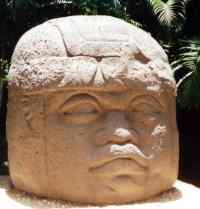The ancient Olmec Civilization
The ancient Olmec civilization is now considered to be one of the earliest great civilizations in Mesoamerica. This civilization came and went long before the Aztec empire was even thought of, and yet they left their mark on the peoples of Mexico and beyond, and developed a complex culture which is still echoed today, probably in ways we don't yet even realize. (See this possible timeline including the Olmec and Aztec civilizations)
The basics
 A great stone head from the Olmec civilization at the Smithsonian Institution |
The Olmec civilization is believed to have been centred around the southern Gulf Coast of Mexico area (today the states of Veracruz and Tabasco) - further south east than the heart of the Aztec empire. The Olmec culture developed in the centuries before 1200BC (BCE), and declined around 400BC.
We know far less about the Olmecs than we do about, for example, the Aztecs and Mayans. There are very few written records to tell us about the culture. In fact, at first Olmec artifacts were thought to be Mayan, and the Mayans were thought to be the first great culture in the area. The generally accepted belief is that the culture arose from people in the area, although some have suggested that the Olmecs may have originally come from Africa.
Olmec civilization
The major Olmec urban area in early times was San Lorenzo Tenochtitlán, at the time the largest city in Mesoamerica. This was probably a ritual and political place, housing thousands and using an elaborate water and drainage system. The city and in fact the ancient Olmec civilization is often remembered because of the gigantic stone heads that have been found here.
There are a couple of reasons why the Olmecs are so important. First, they used and perhaps developed many things culturally and religiously that were later used by the Mayans and Aztecs and many other cultures. Second, they had a wide influence in their day, which gives us reason to believe that they may be responsible for spreading some of these ideas.
The Olmecs carved stone, jade, and the volcanic rock basalt (used for the great stone heads). The stone was quarried and imported.
We can see similar types of sculpture as far away as central Mexico (the land of the Aztecs) and the states of Oaxaca, Morelos, Guerrero, perhaps even farther.
In 2006, archaeologists unearthed a city that they believed was influenced by the Olmecs, only 40km / 25mi south of Mexico City. A new urban society related to the Olmecs suggests that their influence may have been stronger than we ever suspected. Read more about the city of Zazacatla and the ancient Olmec civilization.
The Olmecs had a rich society, traded with far away peoples and ate a wide variety of foods (did they pioneer some dishes of Aztec food?).

Another Olmec head, courtesy of Wikipedia (cc-by-sa license)
Influence of the Olmecs
So aside from trade and carving, how did the Olmecs influence Mexico, and eventually the Aztec empire? We're uncertain, but it's believed that they may have been early adopters of the complex religious system that the Mayans and the Aztecs would use. Temple mounds, jaguars, many gods, and perhaps even human sacrifice were used by the Olmec society. The jaguar is a common figure in Olmec religion - especially combined with a snake or human child.
The layout of their newer city (after the decline of San Lorenzo Tenochtitlán), La Venta, would be copied by future societies.
The calendar used for centuries in Mexico may also have originated with the Olmec. Their astronomy was also carried on by later groups. They were probably obsess with the timing of religious ritual, as the Mayans and Aztec would be after them.
Even the ritual ball game so popular among the Aztecs is believed to have been played in the ancient Olmec civilization.
What other Olmec influences were still felt in the Aztec empire? Music? The hierarchy of society? Laws? It may be that the influence of the ancient Olmec civilization is far greater than we now understand.